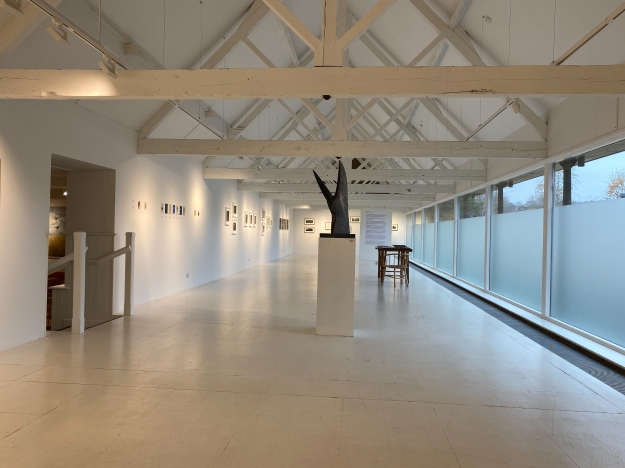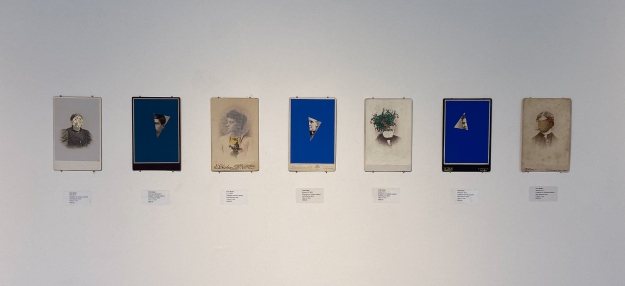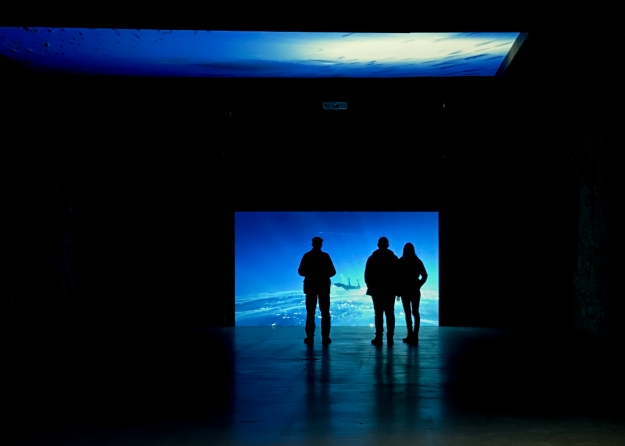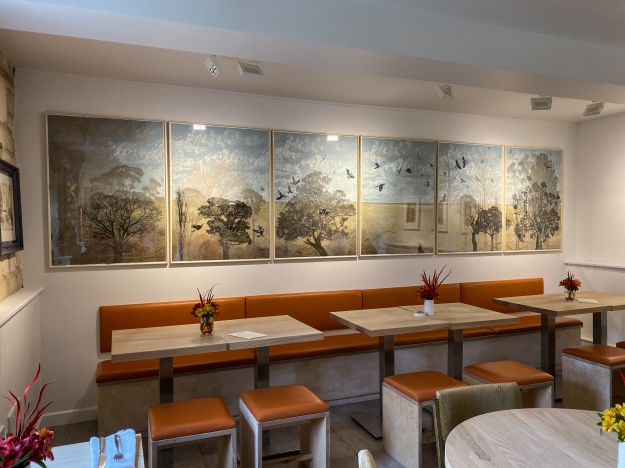As with every single assignment I have done up until now, the subject of this one has become way more complicated than I had originally intended it to be. En route to my current position, I have been thinking about how our personal relationships with photographers can affect how we view their images, alongside how family memories and understood truths change over time as stories are gradually fragmented and reimagined by the people who keep them alive.
The background for the assignment started from a desire to explore old family photographs through crafting methods that are traditionally thought of as feminine. By declaring that arts such as sewing, paper-cutting and patchwork, for example, are crafts, Western (patriarchal) society has traditionally rendered them somehow less worthy than more masculine arts such as writing, painting, etc. As anyone who has visited a high level craft exhibition will know, the creativity, talent and execution of womens’ arts is obviously of a similar level to any so-called masculine pastime, but because many of the ‘crafts’ originated through the need for clothing and household goods, they have generally been considered as artisanal, rather than artistic. Things are changing, but slower than one might hope.
Historical background
Altered photographs have been around for almost as long as photography itself. Traditionally, the alteration has come in the form of photomontages and collages (the distinction between the two being defined here) (1), with many 20th century examples being overtly political in content, such as Hannah Hoch‘s Dada pieces (2) advertising pieces and Peter Kennard‘s anti nuclear war images (3). However, I am more interested in how images can be physically altered using techniques which have come directly from the craft arena, such as embroidery on photographs (Maurizio Anzeri, (4) Shaun Kardinal, (5) Diana Meyer, (6) Julie Cockburn (7) and Hinke Schreuders (8) and paper crafts (Joe Rudko, (9) John Stezaker). (10)
These paper craft interventions really began by mistake, with the Farm Security Association’s mutilation of rejected negatives for their project on the Great Depression by famous photographers such as Dorothea Lange and Walker Evans by punching holes in the negatives. An excellent explanation of what happened and why can be found in Maev Kennedy’s (2018) review of the exhibition Killed Negatives (11) at the Whitechapel Gallery this year, which sadly I did not manage to see. The holes were made to prevent them from being used, but they alter the originals and their addition produces another story, layered on top of the original purpose.
Bringing this forward, the duo Adam Broomberg and Oliver Chanarin used a reversed technique in People In Trouble Laughing Pushed To The Ground, (12) which took images from the Irish Troubles which had been made for news organisations, and which had subsequently been catalogued using different coloured dots pasted on the photographs. Broomberg & Chanarin’s project looked underneath those dots to find the random world of minutiae which occurred around the events which were the subjects of the original photographs.
Another method of altering images is to rearrange the elements of photographs, and the work of Kensuke Koike, and in particular Single Image Processing (Koike, 2018)(13,14) has been a crucial precursor to this assignment. Koike began by taking found photographs and carefully cut elements out and then rearranged them to make visually interesting comments on the originals. The integrity of the original is retained, as it is all still part of the new photograph. I wish to come back to this principle in a later section of this blog post. (see below), but in the meantime, it was frustration at my inability to cut photographs cleanly by hand that made me go out and buy the Silhouette Cameo cutting machine, which has opened up a host of possibilities for my work in this area. Some previous posts detailing my progress can be seen here.
https://hollyocadic.wordpress.com/category/coursework/part-1-the-constructed-image/preparation-for-assignment-1/
The final artist who has been important in driving my thinking has been Pippa Drylaga. She is primarily a paper artist, who produces beautiful delicate pieces of work, but alongside this she explores paper cutting and print making in different media. I found her series Forgotten Moments of Someone Else’s Past (15) while I was looking at her other work, and it uses the same techniques that I am exploring on photographs from an album she bought at a second-hand shop. It is fascinating to see how the cut images differ from their originals, simply because she has made patterns of the background to the unknown people.
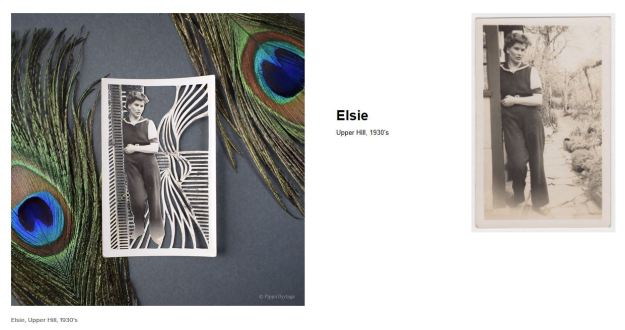
Fig. 1 Elsie, Upper Hills, 1930’s (s.d.)
[This is also of interest at a design level, and is something I may come back to later. Often, a pattern of cuts on an image completely obscures the subject, but brings out the colours of the photograph in wonderful abstract ways. Three of my own examples are shown below, as illustration.]
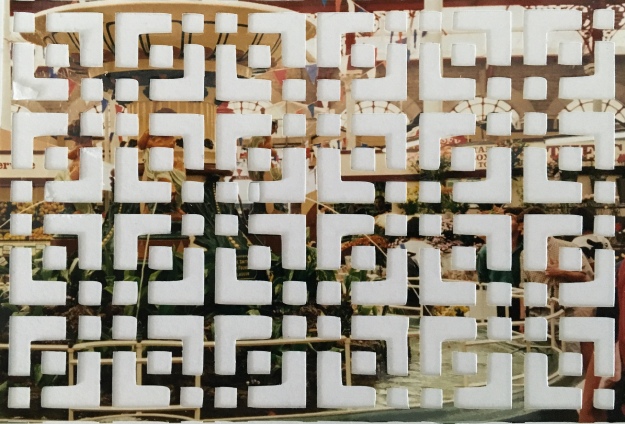
Fig. 2 Cut grid pattern. (2018)
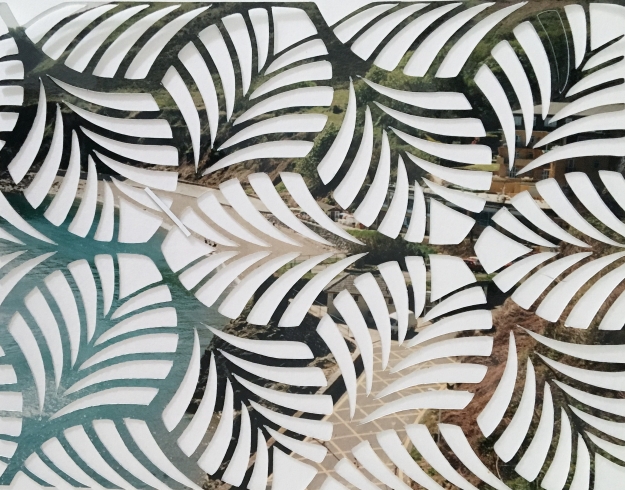
Fig. 3 Cut leaf pattern. (2018)
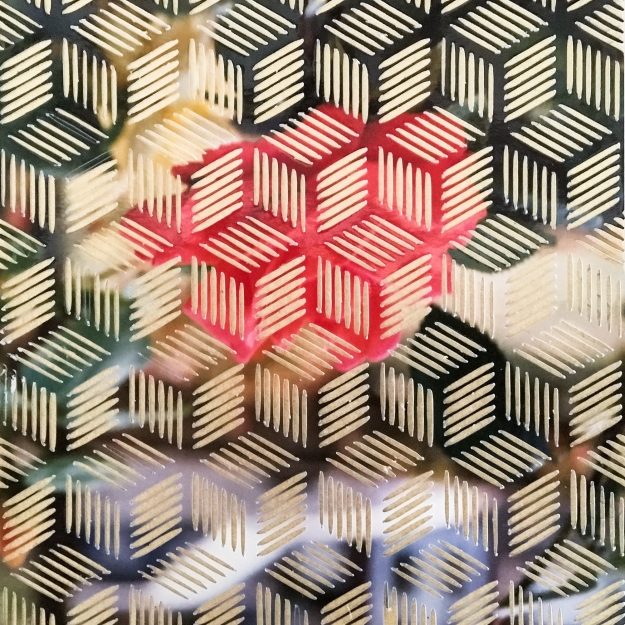
Fig. 4 Cut cubes pattern. (2018)
Some thoughts on altering photographs
John Stezaker, another collage artist, said in a Guardian article recently, ‘cutting a photograph can feel like cutting through flesh‘ (Guardian, 2014) (16) There is no doubt that it is not as straightforward as cutting a plain piece of paper. The photograph is imbued with meaning and links us to our past and that of our family. I feel the same when cutting pages from a book or a map; spoiling something of value, however notional. It needs to be done with care and an acknowledgement of the feelings of the viewer about the photographer and the subject, whether that be a person or a scene.
Most of the artists and photographers I mention above have been working with ‘found’ photographs, where they have no connection with the photographer or subject, and even so, they treat them with respect and try not to waste them. In my own case though, I am working with photographs from my partner’s family archive, and therefore the potential for causing hurt and offence is more immediate. To give a little background, my father-in-law was an enthusiastic but not particularly accomplished photographer, who collected literally thousands of images during his lifetime. From what I can see, he never threw any of his less successful images away, and instead indexed and filed them carefully away in boxes and albums.
Following his death early this year, his children had the not inconsiderable task of sorting out these images, and I offered to do some initial weeding to make the task easier for them. The photos I have acquired consist of snaps of holiday locations, flowers and gardens, events long in the past and some of the most out of focus or over/underexposed pictures of family. I have been careful to steer clear of anything that could potentially have local history or sentimental family value. Using these as a starting point, I have tried to limit my early explorations to the least interesting ones, and to keep better images for later. Wherever possible, images with members of the family have not been used, except for a couple that specifically chose to consider the importance of the face to an alteration (post here) (17)
At a recent study day where I was presenting my work, a couple of people suggested that what I was doing to the images was destructive, and even ‘brutal’. That was never the intention. Right at the start, I explained to my in-laws that I wanted to make something interesting out of the most mundane of the collection and they were happy with that idea. So far, I believe that I have stayed true to that ambition.
Having said that, there is a whole area of study to be explored around appropriation of photographs, and the ethics and emotional aspects of repurposing family photographs, with their innate connection with our understanding of our family’s past and their ability to stand in for memories. Tinkering with this makes the possibility of accusations of misappropriation and re-writing history possible. However, by only using images from the archive without people, I can largely avoid these issues, and I see this assignment work as fitting more closely to the type of collage work of artists such as Joe Rudko, (9) who tears up old and found photos to make interesting geometric patchwork style pieces.
Figures
Fig. 1 Drylaga, P. (s.d.) Elsie, Upper Hills, 1930’s. [Screenshot from artist’s website] At: https://www.pippadyrlaga.com/forgottenfaces (Accessed 27/02/2020)
Fig. 2-4 Woodward, H. (2018) Cut shapes on found photographs [Altered photographs] In possession of: the author.
References
Anzeri, M. (2018). Maurizio Anzeri. At: http://maurizioanzeri.com/ (Accessed 14/08/2018)
The Approach (2018) John Stezaker. At: https://theapproach.co.uk/artists/john-stezaker/images/ (Accessed 14/08/2018)
The Art Story (n.d.) Hannah Höch: German Photomontage artist. At: https://www.theartstory.org/artist-hoch-hannah.htm (Accessed 14/08/2018))
Cardinal, S. (2013) Alterations (Found and Unbound), 2013. At: http://shaunkardinal.com/2013/alterations-found-and-unbound/ (Accessed 14/08/2018)
Cartmell, P. (n.d.) Difference Between a Montage & a Collage. At: https://www.ehow.com/facts_5705493_difference-between-montage-collage.html (Accessed 14/08/2018)
Drylaga, P. (2018) Forgotten Moments of Someone Else’s Past. At: https://www.pippadyrlaga.com/forgottenfaces (Accessed 14/08/2018)
Kennard, P. (2018) Peter Kennard. At: http://www.peterkennard.com/photomontage/ (Accessed 14/08/2018)
Kennedy, Maev (2018) ‘Censored images of 1930s America to go on show in London.’ In: The Guardian [online] At: https://www.theguardian.com/artanddesign/2018/may/06/censored-images-of-1930s-america-to-go-on-show-in-london (Accessed 14/08/2018)
Koike, K. (n.d.) Single Image Processing. At: https://www.kensukekoike.com/project/single-image-processing/ (Accessed 14/08/2018)
Lachowskyj, C. (2014?) ‘Nothing Added, Nothing Removed.’ In: Lensculture. At: https://www.lensculture.com/articles/kensuke-koike-nothing-added-nothing-removed (Accessed 14/08/2018)
Meyer, D. (n.d.) Diana Meyer. At: http://www.dianemeyer.net/ (Accessed 14/08/2018)
O’Hagan, S. (2014) ‘John Stezaker: ‘cutting a photograph can feel like cutting through flesh’. In: The Guardian. [online] At:
https://www.theguardian.com/artanddesign/australia-culture-blog/2014/mar/27/john-stezaker-sydney-biennale (Accessed 14/08/2018)
People in trouble laughing pushed to the ground, Adam Broomberg & Oliver Chanarin (2014) Interview by Book Jockey (Olmo González) [online] At: https://vimeo.com/97337922 (Accessed 14/08/2018)
The Photographers’ Gallery (n.d.) Julie Cockburn. At: https://thephotographersgallery.org.uk/print-sales/explore-artists/julie-cockburn (Accessed 14/08/2018)
Rudko, J. (2018) Joe Rudko. At: http://www.joerudko.com/ (Accessed 14/08/2018)
Schreuders, H. (2018) Hinke Schreuders. At: http://www.sudsandsoda.com/work.html (Accessed 14/08/2018)
Woodward, H. (2018) ‘More experiments for assignment 1.’ In: Holly’s Digital Image & Culture Blog, 11 July At: https://hollyocadic.wordpress.com/2018/07/11/more-experiments-for-assignment-1/ (Accessed 14/08/2018)
